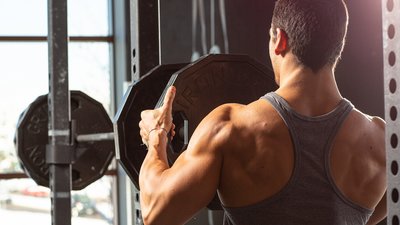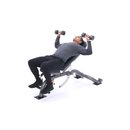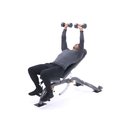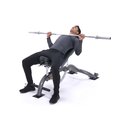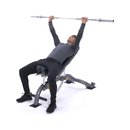"Hey man, how much can you bench?" That's a question I would imagine a lot of people reading this have heard before. The bench press is possibly the most impressive lift you can show off to people... if you can move a lot of weight that is.
For this reason, many aspiring bodybuilders will start every workout with 4-6 sets of bench press, maybe do a couple sets of flyes or cable crossovers and be finished with their workout. And sure, I guess doing that will improve your bench press quite effectively. But if you do this for 12 weeks or more, you'll notice something about your pecs. They've started to look like Man-Boobs!
Upper Chest
To achieve overall development of the pectoral muscle, you will need to work the Clavicular 'head' of the pec as well. Now, the pectoral is only one muscle, there is no actual separation in the muscle like there is in the deltoids, but because the muscle ties in at both the sternum and the clavicle, it is possible to shift emphasis to whichever part of the pec you wish.
People may tell you that the bench press builds 'Overall chest mass', and this is true to a certain extent. However, for the majority of people (genetically gifted people are the exception) it doesn't stimulate enough muscle fiber in the upper pec region. This is how the horrible saggy pec is achieved. In my personal experience, I also found it difficult to achieve that full, 3-D look without enough upper chest. So what did I do to fix it? Well...
Incline Me? Incline You!
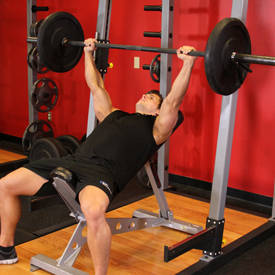
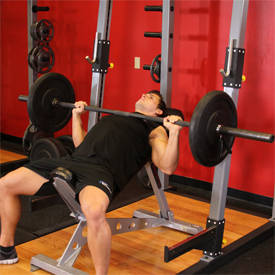
Barbell Incline Bench Press
No, you're right, that title made no sense at all... Incline! That's what I was missing, and if you are suffering (it's a type of pain) from the afore mentioned 'Saggy pec', then it's almost certainly what you're missing too!
One reason I've found, among people I train with, that incline movements aren't used as commonly as flat or decline, is simply because people can't use as much weight. Well I'm gonna tell you now, that if you want a chest that looks good, you're gonna have to swallow your pride and hit the incline!
I'm not saying that you can't perform flat bench as well, in fact, it's very important that you do this too. But I strongly suggest starting your workouts with an incline pressing movement. This will allow you to work your upper chest with maximum strength and intensity.
Another thing that I feel is imperative to achieving a well built upper chest is a full range of motion. Using a whole load of weight for a 2-inch range of motion just won't cut it. This brings me on to my next point. To start with at least, I would suggest that you use incline dumbbell press as your first chest exercise. A barbell can only be brought down to chest level, whereas dumbbells can go lower.
When performing dumbbell presses, or any other press for that matter, I feel it is important to keep constant tension on the muscle. This means you should not pause at any time during the set. If you are used to pausing after 7 or 8 reps, in order to get a couple more reps out, then doing this will come as a bit of a shock. You won't be able to use as much weight, and it'll hurt a lot more. So what's the appeal? GROWTH! (and pain might be your thing... I don't judge).
The Routine
So, I'd done my research, and I'd gotten some ideas as to how I could bring out my upper chest, but I still needed to put it into some sort of routine. Because my upper chest was really lagging behind, I decided that 16 weeks should be enough time to even things out.
The routine will consist of 3 pressing movements and an isolation exercise. I feel that this will focus on building mass, but the isolation exercise will hit the pecs in a different way, and result in more growth. I was using a 3-1 upper/lower ratio. This means that I would be doing 3 exercises for my upper chest and 1 for my lower chest.
It's important to keep working the lower portion of the chest, even though the focus is on the upper chest. Doing this will ensure that you maintain your lower chest strength and size, but without really adding a great deal of size to it. Below I have laid out the routine I used:

BodyFit
$6.99/month- 2,500+ expert-created single workouts
- 3,500+ how-to exercise videos
- Detailed workout instruction
- Step-by-step workout tips
- Training at gym or at home
- Access to Workout Plans
- Access to Bodyfit App
- Store Discounts
Already have a Bodybuilding.com account with BodyFit? Sign In

What comes with BodyFit?

- Instructional Videos
Don't risk doing a workout improperly! Avoid injury and keep your form in check with in-depth instructional videos.

- How-to Images
View our enormous library of workout photos and see exactly how each exercise should be done before you give it a shot.

- Step-by-Step Instructions
Quickly read through our step-by-step directions to ensure you're doing each workout correctly the first time, every time.

BodyFit
$6.99/month- 2,500+ expert-created single workouts
- 3,500+ how-to exercise videos
- Detailed workout instruction
- Step-by-step workout tips
- Training at gym or at home
- Access to Workout Plans
- Access to Bodyfit App
- Store Discounts
Already have a Bodybuilding.com account with BodyFit? Sign In

What comes with BodyFit?

- Instructional Videos
Don't risk doing a workout improperly! Avoid injury and keep your form in check with in-depth instructional videos.

- How-to Images
View our enormous library of workout photos and see exactly how each exercise should be done before you give it a shot.

- Step-by-Step Instructions
Quickly read through our step-by-step directions to ensure you're doing each workout correctly the first time, every time.

BodyFit
$6.99/month- 2,500+ expert-created single workouts
- 3,500+ how-to exercise videos
- Detailed workout instruction
- Step-by-step workout tips
- Training at gym or at home
- Access to Workout Plans
- Access to Bodyfit App
- Store Discounts
Already have a Bodybuilding.com account with BodyFit? Sign In

What comes with BodyFit?

- Instructional Videos
Don't risk doing a workout improperly! Avoid injury and keep your form in check with in-depth instructional videos.

- How-to Images
View our enormous library of workout photos and see exactly how each exercise should be done before you give it a shot.

- Step-by-Step Instructions
Quickly read through our step-by-step directions to ensure you're doing each workout correctly the first time, every time.

BodyFit
$6.99/month- 2,500+ expert-created single workouts
- 3,500+ how-to exercise videos
- Detailed workout instruction
- Step-by-step workout tips
- Training at gym or at home
- Access to Workout Plans
- Access to Bodyfit App
- Store Discounts
Already have a Bodybuilding.com account with BodyFit? Sign In

What comes with BodyFit?

- Instructional Videos
Don't risk doing a workout improperly! Avoid injury and keep your form in check with in-depth instructional videos.

- How-to Images
View our enormous library of workout photos and see exactly how each exercise should be done before you give it a shot.

- Step-by-Step Instructions
Quickly read through our step-by-step directions to ensure you're doing each workout correctly the first time, every time.
Now the first thing I want to stress about this workout is that the amount of volume I used won't be fitting for everyone. A lot of people will look at that and think, "That's too much volume!", and they might well be correct. My body has only ever responded to high volume training, even when I started training. So my suggestion is to use the appropriate amount of volume for your body.
I used a variety of rep ranges in this routine, however I mainly stick to the 6-12 rep range. This is because I found this to be most effective for pure hypertrophy. There was a few instances where I'd use a slightly lower or higher rep range.
The lower rep range is to focus more on strength. This probably won't build as much muscle, but the increase in strength will benefit your ability to gain muscle in the long run, as you'll be able to lift more weight when you switch back to the hypertrophy rep range.
The higher rep range focuses on filling the muscle with blood. Not only does this saturate the muscle with the nutrients it needs to grow, but it also increases the muscle's ability to store glycogen. The reason the routine changes so frequently is because your upper chest will be getting worked a lot, and so it will most likely get used to it, and thus wont grow as well.
Again, I stress using a full range of motion. I believe that the amount of muscle fiber you can stimulate is relative the range of motion used. To get the full benefit from this routine, it goes without saying that you should have good nutrition.
Well, that's about it really. After you've finished this 16 week plan, you should go back to working your chest evenly!


